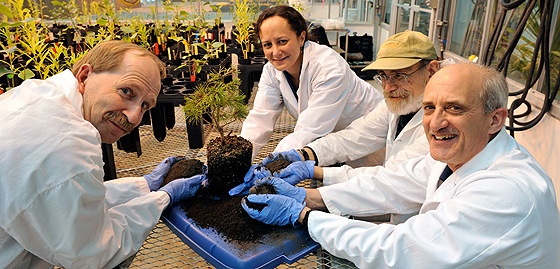UNBC Research: Waste from Cities and Bioenergy Plants could be the Fertilizer of the Future
New research from the University of Northern British Columbia suggests that waste from municipalities and bioenergy plants can be combined to make an ideal fertilizer and help reduce the amount of material added to landfills. The study provides the first insights into the use of wood ash and biosolids as soil amendments for nurseries, forests, and mines in a northern boreal climate.

Media Download (left to right): UNBC Professor Hugues Massicotte, student Nichola Gilbert, Research Assistant Scott Brown, and Professor Mike Rutherford display some ash-enhanced soil in the I.K. Barber Enhanced Forestry Laboratory at UNBC's Prince George campus.
“What we found is that by combining these two waste materials, we make them more than the sum of their parts,” say UNBC Environmental Science Professor Mike Rutherford and Forestry Professor Hugues Massicotte, who both supervised the project conducted by UNBC student Nichola Gilbert. “Bioenergy ash is rich in nutrients, but low in nitrogen while biosolids are high in organic matter and nitrogen. They’re a perfect match that can increase plant growth by more than 200 percent in some soils.”
The research aimed to identify the amounts of ash and biosolids that would best enhance soils in Northern BC. Trials were undertaken to document the growth of plants in deficient soils that had been enriched only with ash, with biosolids, and with ash/biosolid combinations. The project used ash from the University’s award-winning bioenergy plant, local industries, and locally-sourced biosolids. Biosolids are defined as stabilized sewage resulting from municipal wastewater treatment plants, and are sometimes used as fertilizers.
For four months, willow and poplar cuttings were grown in two soils: one from a copper-molybdenum mine site (Gibraltar Mine north of Williams Lake), and one from a bioenergy plantation (Pacific Regeneration Technologies) near Prince George. Overall, wood ash combined with biosolids proved the most fertile.
Locally, both Canfor Pulp and UNBC’s bioenergy plant are producing ash, although many rural and First Nations, off-grid communities in Northern BC have expressed interest in implementing this technology in their communities. Some, such as Gitsegukla near Hazelton, have already started. There are also several local companies producing bioenergy crops, such as Red Rock Bioenergy Crops south of Prince George.
“With industry and communities already operating bioenergy plants – or planning to implement them – this research illustrates potential uses for the ash that emerges from these plants,” says Dr. Rutherford. “The potential is there for communities to complete the ‘sustainability loop,’ and make use of the ash that comes from the bioenergy plants that provide their energy, and the waste produced by their community, to produce the next crop of biomass for the bioenergy plant, and reclaim land after forestry and mining.”
According to the researchers, additional study is needed to optimise the use of ash/biosolid fertilizer on agricultural lands, nurseries, and forested lands. There are opportunities for the use of these amendments in various reclamation and remediation strategies, as well.
“Interestingly, the growth response was more obvious with willow trees compared to poplar,” says Dr. Rutherford. “This reveals that different plant species will behave differently to various amendment levels. The responses will also be determined by soil type.”
Financial support for this research was provided by the Natural Sciences and Engineering Research Council, Canfor Pulp Limited Partnership, Pacific Regeneration Technologies, Gibraltar (Taseko) Mine, and the UNBC I.K. Barber Enhanced Forestry Laboratory.